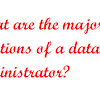|
Delete
|
Drop
|
|
(i)
The DELETE command is used to remove rows from a table.
|
(i)
The DROP command removes a table from the database.
|
|
(ii)
Delete statement performs conditional based deletion.
|
(ii)
Drop command deletes entire records in the table.
|
|
(iii)
Delete is a DLM statement.
|
(iii)
Drop is a DDL command.
|
|
(iv)
Delete operation can be rolled back and it is not auto committed.
|
(iv)
Drop operation cannot be rolled back in any way as it is an auto committed
statement.
|
|
(v)
They require segments in the UNDD table space.
|
(v)
They do not require segments in the UNDO table space.
|
|
(vi)
It can activate the triggers.
|
(vi)
It does not activate the triggers.
|
|
(vii)
The syntax for Delete statement:
DELETE
FROM <table_name>
or,
DELETE
FROM <table_name>
WHERE
<condition>
|
(vii)
The syntax for Drop command DROP TABLE <table_name>
|
11 March 2018

Differentiate between 'delete' arid 'drop'
You May Also Like
- Database Management System
Relational Algebra 2Mar 15, 2018
- Database Management System
Relational Algebra for Banking enterpriseMar 15, 2018
- Database Management System
- Database Management System
Differentiate between 'delete' arid 'drop'Mar 11, 2018
Newer Article
Consider the precedence graph of the following figure. Is the corresponding schedule conflict serializable? Explain your answer.
Older Article
What are the difference between relational algebra and SQL
Labels:
Database Management System
Subscribe to:
Post Comments (Atom)







No comments:
Post a Comment